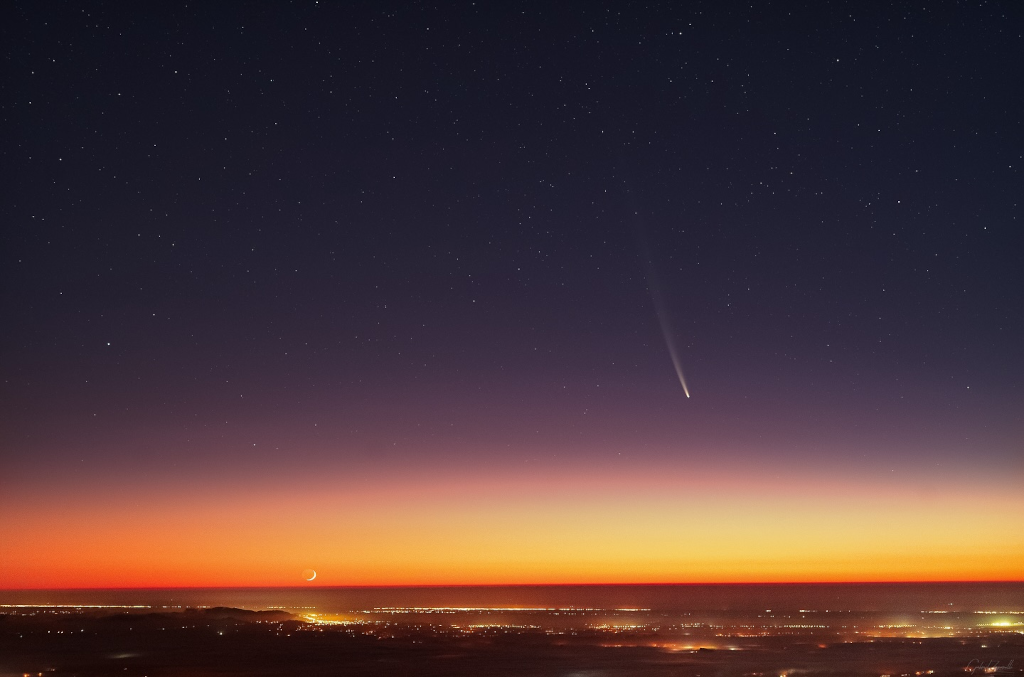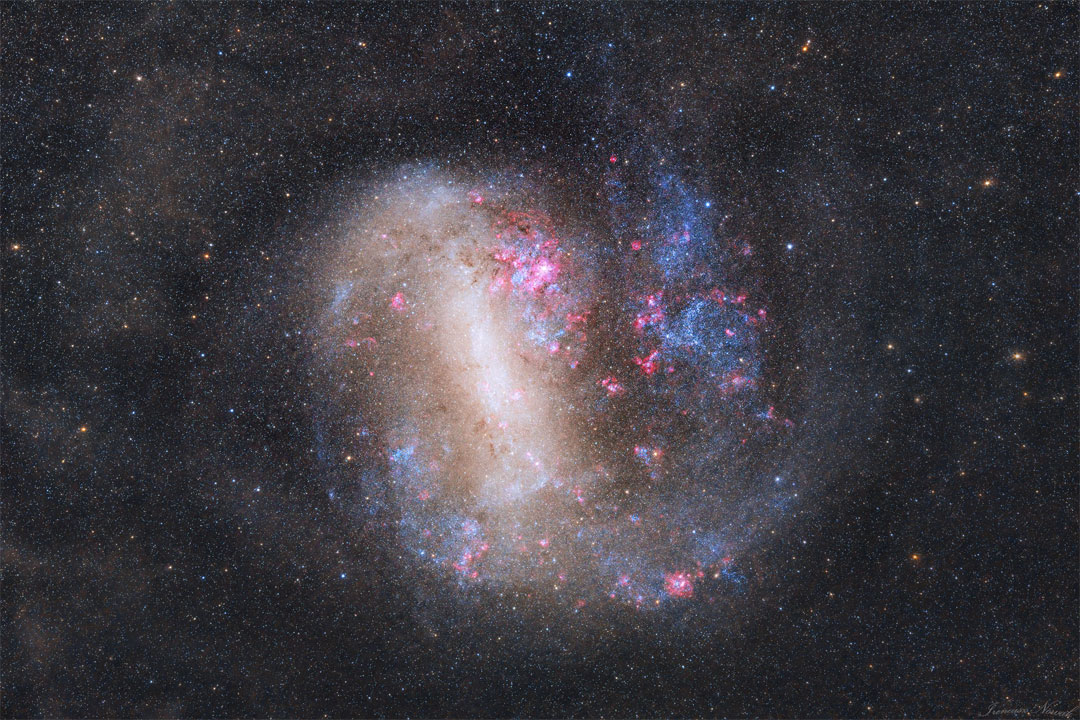Nombre total de pages vues
04/10/2024
ASTRONOMIE - La comète Tsuchinshan-ATLAS approche
ASTRONOMY - Comet at Moonrise
2024 October 4
Image Credit & Copyright: Gabriel Zaparolli
Explanation: Comet C/2023 A3 (Tsuchinshan–ATLAS) is growing brighter in planet Earth's sky. Fondly known as comet A3, this new visitor to the inner Solar System is traveling from the distant Oort cloud. The comet reached perihelion, its closest approach to the Sun, on September 27 and will reach perigee, its closest to our fair planet, on October 12, by then becoming an evening sky apparition. But comet A3 was an early morning riser on September 30 when this image was made. Its bright coma and already long tail share a pre-dawn skyscape from Praia Grande, Santa Catarina in southern Brazil with the waning crescent Moon just peeking above the eastern horizon. While the behaviour of comets is notoriously unpredictable, Tsuchinshan–ATLAS could become a comet visually rivaling C/2020 F3 (NEOWISE). Comet NEOWISE wowed skygazers in the summer of 2020.
03/10/2024
ASTRONOMY - Eclipse at Sunrise
2024 October 3
Image Credit & Copyright: Wang Letian (Eyes at Night)
Explanation: The second solar eclipse of 2024 began in the Pacific. On October 2nd the Moon's shadow swept from west to east, with an annular eclipse visible along a narrow antumbral shadow path tracking mostly over ocean, crossing land near the southern tip of South America, and ending in the southern Atlantic. The dramatic total annular eclipse phase is known to some as a ring of fire. Still, a partial eclipse of the Sun was experienced over a wide region. Captured at one of its earliest moments, October's eclipsed Sun is seen just above the clouds near sunrise in this snapshot. The partially eclipsed solar disk is close to the maximum eclipse as seen from Mauna Kea Observatory Visitor Center, Island of Hawaii, planet Earth.
SANTé/MEDECINE - 5 Super Aliments qui Diminuent l'Hypertension
02/10/2024
LES NUAGES - DIEUX DU CIEL - Cirrus jaune-orange au coucher du soleil
ASTRONOMY - The Large Magellanic Cloud Galaxy
Image Credit & Copyright: Ireneusz Nowak; Text: Natalia Lewandowska (SUNY Oswego)
Explanation: It is the largest satellite galaxy of our home Milky Way Galaxy. If you live in the south, the Large Magellanic Cloud (LMC) is quite noticeable, spanning about 10 degrees across the night sky, which is 20 times larger than the full moon towards the southern constellation of the dolphinfish (Dorado). Being only about 160,000 light years away, many details of the LMC's structure can be seen, such as its central bar and its single spiral arm. The LMC harbors numerous stellar nurseries where new stars are being born, which appear in pink in the featured image. It is home to the Tarantula Nebula, the currently most active star forming region in the entire Local Group, a small collection of nearby galaxies dominated by the massive Andromeda and Milky Way galaxies. Studies of the LMC and the Small Magellanic Cloud (SMC) by Henrietta Swan Leavitt led to the discovery of the period-luminosity relationship of Cepheid variable stars that are used to measure distances across the nearby universe.
01/10/2024
PLANTES FASCINANTES - La fascinante ostéospermum d'Afrique du Sud
ASTRONOMY - Porphyrion: The Longest Known Black Hole Jets
2024 October 1
Animation Credit: Science Communication Lab for Martijn Oei et al., Caltech
Explanation: How far can black hole jets extend? A new record was found just recently with the discovery of a 23-million light-year long jet pair from a black hole active billions of years ago. Dubbed Porphyrion for a mythological Greek giant, the impressive jets were created by a type of black hole that does not usually create long jets -- one that is busy creating radiation from infalling gas. The featured animated video depicts what it might look like to circle around this powerful black hole system. Porphyrion is shown as a fast stream of energetic particles, and the bright areas are where these particles are impacting surrounding gas. The discovery was made using data from the Keck and Mayall (DESI) optical observatories as well as LOFAR and the Giant Metrewave Radio Telescope. The existence of these jets demonstrates that black holes can affect not only their home galaxies but far out into the surrounding universe.
LES BELLES INVENTIONS DE LEONARD DE VINCI - Le scaphandre
Aucun dessin connu de Léonard de Vinci ne ressemble exactement à cette image de scaphandre. Toutefois, il en existe qui possèdent certains ...

-
2022 September 26 All the Water on Planet Earth Illustration Credit: Jack Cook, Adam Nieman, Woods Hole Oceanographic Institution ; Data ...
-
2025 May 11 The Surface of Venus from Venera 14 Image Credit: Soviet Planetary Exploration Program , Venera 14 ; Processing & Copyri...








